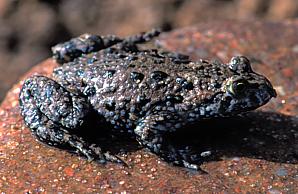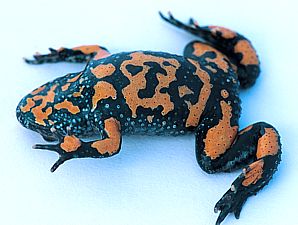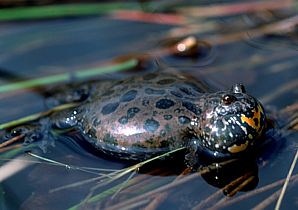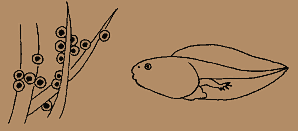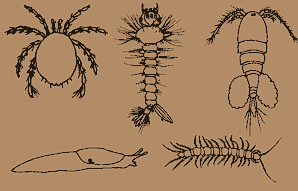|
AMPHIBIANS
|
||||||||||||||||
Text:
|
Fire-bellied toad
FIRE-BELLIED TOADS Bombina look like small toads - their skin is covered with numerous warts - similarly to toads - however they do not have parotids, which are so characteristic for toads. They also lack tympanic membrane. Another feature distinguishing fire-bellied toads from other amphibians is a cordite or triangular shape of the pupil. Venom, which is contained din, the skin glands of the fire-bellied toads is one of the strongest venoms produced by our amphibians.
There are two species of fire-bellied toads in Poland: fire-bellied toad Bombina bombina and mountain fire-bellied toad Bombina variegata. However, only the fire-bellied toad is present in the area of the Wigry National Park.
Fire-bellied toad is present in the central and Western Europe; it is also quite ordinary in Poland in the whole area of the country except for mountainous areas. For its mating It selects areas only small and shallow water reservoirs with standing water, with silty bottom and rich water vegetation, for example: ponds, clay-pits, ditches, rain floodwaters. In the area of the Wigry National Park, it can be found in small, field - water ponds in the lands of several villages, including for example: Rosochaty Róg, Leszczewo, Królewek and Kaletnik.
Dhe length of the body of fire-bellied toad ranges from 4 to 6 centimetres. The dorsal part of the body is pigmented with a dark-brown or black colour while the ventral side of the body is pigmented with the dark-blue or grey - cinereous colours, also covered with irregularly located, orange spots. At the time of danger, a fire-bellied toad employs a characteristic stance: it raises its limbs, presenting lightly coloured inner surfaces of feet and hands.
Fire-bellied toad is the stenothermal animal and presents the strongest link to water environment among all our amphibians. It is rather active during the day, and very seldom during the night. It wakes up from hibernation in April and has its mating season from May to June and sometimes even to July. During the mating season, males develop resonators in an even number- these are air bags, which are located in the bottom of the oral cavity. Males utter characteristic, metallic sounds, which resemble the "U" sound, repeated over and over again. After verbal presentation, males create couples with females; join them in the so-called amplexus after which the female spawns eggs, which are then fertilized by the male. Small clusters of frogspawn are attached to shoots of underwater plants.
Tadpoles hatch after 8 to 10 days. At the end of summer, after the period of intensive feeding, tadpoles undergo transformation and they measure up to approximately 1,5 centimetres at that time. Fire-bellied toads hibernate in groups in clefts burrows or under leaves. It lives approximately 20 years.
Nourishment of a fire-bellied toad constitutes mainly of water animals: arachnids (for example: water mites), crustaceans (cladocerans, copepods, ostracods), larvae and pupae of water insects, while on land they hunt insects (heteropters and ants), myriapodams and snails.
Due to highly toxic secretion of venom glands, fire-bellied toads do not have many natural foes. These include the following species, for example: grass snakes, viper, some raptorial birds, American mink and polecat.
The basic form of protection of fire-bellied toad includes protection of the areas of its reproduction (small, field-water ponds), which consists of deepening ponds, which dry out, or restoring the ones, which have disappeared.
|
|||||||||||||||
|
|
|

